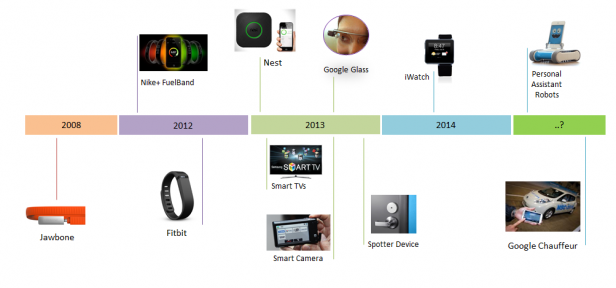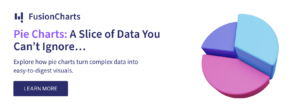This is the 7th and last post in our series,
Real-time Data Visualization. In this post, we briefly trace the history of real-time analytics and then move on to identifying 7 overarching
data analytics trends that will influence the way we use real-time data in the future. One of the earliest applications of real-time analytics was in manufacturing plants to monitor the performance and health of their systems in real time.
Data like temperature, weight, and volume were monitored by sensors embedded at strategic points in a manufacturing system. These sensors would update the monitoring
reporting dashboard in real-time, giving visibility and control over the performance and output. Not just in systems, but RFID technology and surveillance cameras drastically increased the applications of real-time analytics in security and human resource allocation in these manufacturing plants.
It would be only a matter of time before this kind of recording of real-world information was made possible outside the manufacturing and industrial sectors.
The Internet of Things

Today, we see a wave of connected devices flooding the consumer market and throwing open new doors of opportunity for consumers and businesses alike. Makes us wonder what the future of real-time analytics holds for us. Here are 7
data analytics trends that could turn out to be defining factors as the future of real-time analytics unfolds:
1. The Internet of Things will grow in leaps and bounds
In the past two decades, the explosion of data across the internet is largely credited to the availability of devices like digital cameras and mobile phones. However, this is just the beginning. Gartner estimates 20B connected devices by 2020, a 30-fold increase from what we see today.
We’ve already seen successful products from Nike Fuelband, Fitbit, and Jawbone Up, which offer a variety of wearable devices that capture data about a user’s physical activity in real time. Smart devices are even invading our homes in the form of smart TVs and other
connected home appliances. The interest isn’t restricted to just the consumer electronics companies; even Google, with its Google Glass and self-driving cars, is pushing the limits of what devices can do for us.
Apple has a rumored iWatch product in the pipeline, and some companies are betting on robots being our personal assistants of the future. All these devices, while assisting us in our daily lives, will add to the amount of real time data available. This has raised privacy concerns by some, but the opportunities it presents are too alluring to avoid. However,
things that can impact data analysis, such as data privacy concerns, security vulnerabilities, and the sheer volume of information generated, must be carefully considered. Despite these challenges, the opportunities presented by these advancements are too alluring to avoid.
2. Consumer technology has a boomerang effect on businesses
At the start of this post, we saw how real-time technology originated in manufacturing businesses, after which it trickled down to the consumer space, particularly with mobile phones. However, what we’re seeing now, with the advent of the social web and the explosion of connected devices, is a
reversal of that trend. Consumer technology is changing the way we do business.
Work culture is being changed by policies like
Bring your own device. and enterprise applications that borrow design principles from popular consumer applications. Companies are embracing social media platforms for their sales, marketing, support,
advanced race data analytics, recruiting, and other key functions. Even traditional B2B platforms like
SalesForce have been expanding their offerings to embrace the social web.
3. Automation will become mainstream

We’ve only seen the beginning of connected devices that can perform user-specified tasks. For example, a
Spotter can be programmed to send an alert via SMS or email if there’s a change in the temperature of an appliance.
IFTTT, a popular automation tool, makes it extremely easy to specify ‘if this then that’ functions on some of our most commonly used apps like Gmail, Evernote, Twitter, and
Facebook.
This sort of technology, though in its infancy now, is set to grow exponentially in the coming years. Increasingly, we’ll see this trend pick up pace in business scenarios as well.
Big data technologies will allow businesses to crunch huge volumes of data to execute specific functions automatically. Personalized marketing campaigns, laser-focused sales pitches, and intuitive support are some of the business applications of this technology.
4. Big data technologies make real-time analytics more accessible
Hadoop is known for batch processing large data sets but has been too slow for the demanding needs of
real time analytics. However, with Hadoop 2.0, YARN makes the platform even more extensible, opening it up to work with real-time technologies. We’re already seeing the community endorse
Storm, making it a default of the Hadoop platform.
This trend is just getting started, and in the coming years, we can expect multiple options for companies of all sizes and types to employ real-time systems. While these advancements are promising, they also highlight some
difficulties encountered in data analytics, such as managing large volumes of data, ensuring real-time accuracy, and overcoming system scalability challenge
5. Agile approach in reporting

Businesses will realize that the big data revolution is not really about technology but about the change in culture and mindset. This will push them to rethink how they access, process, and use data. Rather than build one all-encompassing tool that handles all data, the norm will be to let the tools serve the purpose. We’re already seeing signs of that with real-time aggregation dashboards like Geckoboard. Executives will awaken to the possibility of accessing data using flexible methods in a way that wasn’t possible before.
6. Move from real-time to right-time analytics
The
advancement of technology will push the limits on what’s possible, but on the downside, it obscures what’s really necessary. The paradox of choice. Businesses will be averse to
data overload and demand more from real-time applications. The focus will shift from not just reporting data in real-time to reporting it at the right time and the right way, making it actionable and useful. As part of emerging
trends in data analytics, this shift will emphasize smarter, more targeted insights, enabling businesses to act decisively and maximize the value of their data.
7. Data literacy increases
Google’s Hal Varian believes that data science is set to be
the sexy job in the next ten years. VCs have noticed the potential in data startups. All this points to data moving from being an optional luxury to a mainstream necessity in business and consumer applications. This means that users will become more literate and demanding of an application’s data capabilities. Rather than regular text and numbers, users will demand delightful visualizations and interactive experiences to get more from their data.
I’ll leave it to you to decide which of these
data analytics trends will last and which will fade away. But hopefully, you see that whatever direction the future takes, real time data will play an essential part in how we work and live. If you enjoyed this read, do get our white paper titled
‘The Ultimate Guide to Real-time Data Visualization.’ It discusses the topic in more detail, complete with real-world examples and specific guidelines for choosing a real-time charting solution.
Top Challenges of Real-Time Analytics
Plenty of
data analytics challenges are there which can include anything from creating an architecture and changing business processes to training employees. Let’s discuss a few of them here:
Data Overload:
Managing the vast volumes of data generated in real-time can be overwhelming, making it difficult to process and make actionable decisions.
Data Accuracy:
It is crucial to ensure that the
accuracy of the data in real-time is precise and reliable, but the speed of data generation can lead to inconsistencies or errors.
Data Integration:
Combining data from various sources with different formats and protocols can be complex, especially when trying to analyze in real-time.
Latency:
Minimizing delays in processing data is essential. Even slight lag can result in lost opportunities or incorrect decisions, especially in fast-paced industries.
Cost of Infrastructure:
Real time analytics requires substantial investment in technology, such as hardware, software, and skilled personnel, which can be a barrier for many organizations.
Conclusion
In conclusion, real time analytics transforms how we work and live by driving innovation, improving efficiency, and reshaping industries. From the rise of IoT devices and automation to adopting big data technologies and agile reporting methods, these
data analytics trends highlight a future where data is more accessible, actionable, and impactful.
As businesses shift from real-time to right-time analytics, they will focus on delivering insights at the most critical moments. With increasing data literacy and the growing demand for intuitive visualizations,
real time analytics is poised to remain a cornerstone of technological advancement and societal progress for years to come.
Take the Next Step with Real-Time Data Analytics
Ready to harness the power of real-time analytics to transform your business or everyday operations? Unlock the full potential of your data by integrating advanced real-time analytics solutions. Whether you’re looking to enhance your
dashboards, utilize real-time charts, or explore a wide range of charting options, FusionCharts offers powerful tools to help you make real-time data-driven decisions. Check out
FusionCharts’ Real-Time Charts to instantly visualize and act on your data. Don’t wait for tomorrow’s insights—empower your organization today!
Frequently Asked Questions
1. What are the capabilities of real time data analytics?
Real-time data analytics enables instant processing and insights from data as it is generated, improving decision-making speed. It supports monitoring trends, detecting anomalies, and automating responses. This capability is vital in industries like finance, healthcare, and e-commerce.
2. What are some of the challenges of real time data processing?
The
data analytics challenges include handling high data volumes and velocity while maintaining low latency. Ensuring data quality and system scalability adds complexity. Additionally, real-time systems require robust infrastructure and significant resource investment.
3. What is the process of analyzing data in real-time as it is generated?
Real-time analytics involves collecting data from various sources, processing it using stream processing tools, and delivering insights instantly. This process relies on advanced technologies like Apache Kafka or Spark. Visualizations and alerts are generated to assist immediate action.
4. What is the main benefit of real-time analytics in big data?
The main benefit is the ability to make faster, data-driven decisions, leading to improved operational efficiency. It helps businesses adapt quickly to changing conditions and enhance customer experiences. Real-time insights are crucial for staying competitive in dynamic industries.
 Today, we see a wave of connected devices flooding the consumer market and throwing open new doors of opportunity for consumers and businesses alike. Makes us wonder what the future of real-time analytics holds for us. Here are 7 data analytics trends that could turn out to be defining factors as the future of real-time analytics unfolds:
Today, we see a wave of connected devices flooding the consumer market and throwing open new doors of opportunity for consumers and businesses alike. Makes us wonder what the future of real-time analytics holds for us. Here are 7 data analytics trends that could turn out to be defining factors as the future of real-time analytics unfolds:
 We’ve only seen the beginning of connected devices that can perform user-specified tasks. For example, a Spotter can be programmed to send an alert via SMS or email if there’s a change in the temperature of an appliance. IFTTT, a popular automation tool, makes it extremely easy to specify ‘if this then that’ functions on some of our most commonly used apps like Gmail, Evernote, Twitter, and Facebook.
This sort of technology, though in its infancy now, is set to grow exponentially in the coming years. Increasingly, we’ll see this trend pick up pace in business scenarios as well. Big data technologies will allow businesses to crunch huge volumes of data to execute specific functions automatically. Personalized marketing campaigns, laser-focused sales pitches, and intuitive support are some of the business applications of this technology.
We’ve only seen the beginning of connected devices that can perform user-specified tasks. For example, a Spotter can be programmed to send an alert via SMS or email if there’s a change in the temperature of an appliance. IFTTT, a popular automation tool, makes it extremely easy to specify ‘if this then that’ functions on some of our most commonly used apps like Gmail, Evernote, Twitter, and Facebook.
This sort of technology, though in its infancy now, is set to grow exponentially in the coming years. Increasingly, we’ll see this trend pick up pace in business scenarios as well. Big data technologies will allow businesses to crunch huge volumes of data to execute specific functions automatically. Personalized marketing campaigns, laser-focused sales pitches, and intuitive support are some of the business applications of this technology.



